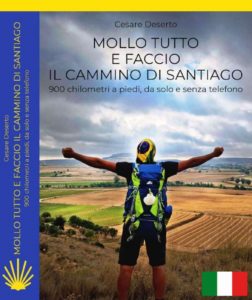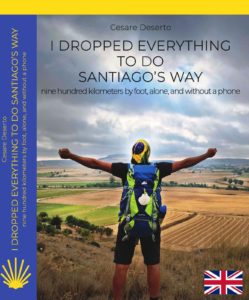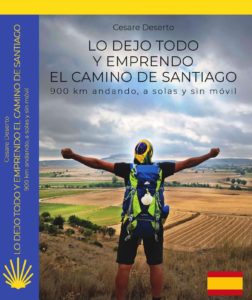The Camino de Santiago de Compostela is the long journey that pilgrims have taken since the Middle Ages, through France and Spain, to reach the sanctuary of Santiago de Compostela, near which there is the tomb with the relics of St. James the Apostle. In fact, the word Santiago in Italian translates as San Giacomo. The French and Spanish roads that make up the itinerary have been declared a World Heritage Site by UNESCO. James the Apostle, son of Zebedee, a fisherman, was one of the 12 apostles, like his brother John the Evangelist. After the resurrection of Christ for many years he toured the Iberian peninsula to carry out the work of evangelization in Spain, reaching as far as Galicia, a remote region of Celtic culture in the extreme west of the Iberian peninsula. Back in Palestine he was beheaded by King Herod Agrippa, who feared that the apostle would acquire excessive power; his disciples Attanasio and Teodoro collected the body and transported it secretly with a ship to the places of preaching led by an Angel. Disembarked near Finisterre they entered Galicia and here they buried it, in a wood near Iria Flavia, the most important Roman port in the area. Following prohibitions on visiting the burial site due to Muslim influence, traces and memory had been lost but, in the year 813, the hermit Pelayo saw, for many days after, a shower of stars falling on a hill, the mountain Liberon.
One night St. James appeared to him in a dream who revealed to him that the place of lights indicated his tomb. The abbot removed the earth that had deposited over the centuries and discovered the tomb. He gave news to the local Bishop Teodomiro who, interested by the strange phenomenon, confirmed its truthfulness by discovering in that place a tomb, probably from the Roman era, which contained three bodies, one of which with a severed head and bearing the inscription: “Here lies Jacobus , son of Zebedee and Salomé “. For this reason it is thought that the word Compostela derives from Campus Stellae (field of the star). From the moment bishop Teodomiro recognized the finding of the hermit as valid by building a temple in Santiago de Compostela, the wonders, miracles and apparitions multiplied giving rise to a rich collection of stories intended to instill courage in the Christian warriors who fought against the advance of the Moors and to raise the spirits of the pilgrims who, very soon, began their slow journey along the Camino de Santiago.
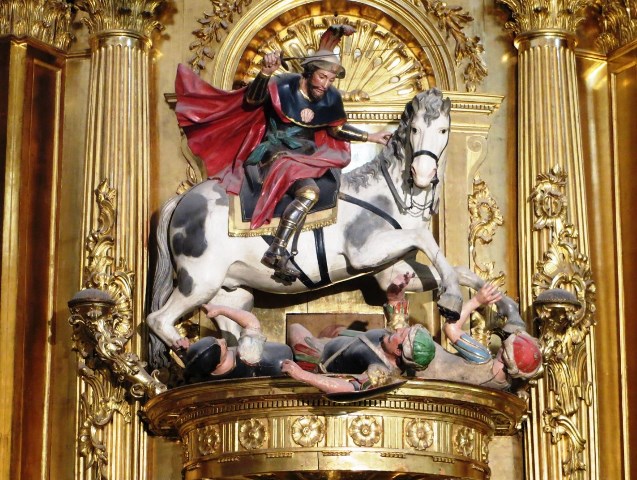
The same path that Charlemagne first walked when St. James himself, appearing to him in a dream, showed him the “way of the stars” to follow to reach the place of his burial. In the Middle Ages, faced with the Muslim threat, the city, where the remains of Santiago rested, became a symbol of Christianity, a bulwark that, in the presence of the Moors, now undisputed masters of southern Spain, attested to the strength and vigor of the Western religious tradition. But it was not only Christians animated by faith who set out on the journey; starting from the 15th century, the pilgrimage to Santiago also became a penalty imposed for the crimes committed. You went to Santiago to perform a penance for your sins or you could be condemned to atone for on the Way simply for having insulted an enemy! Today the Way is constantly marked with signs that accompany the traveler from the Pyrenees to Galicia. Walking along it without being in a hurry, one quickly realizes that the route is not only indicated by the modern yellow-blue signs distinguished by the shell but by countless much older “signs”. Romanesque churches with admirable portals in which figures of characters from the Old and New Testament crowd, animals with the strangest shapes and recurring symbols such as the chessboard and the shell, hospices and monasteries, hermitages and abbeys, images of Santiago and statues of the Madonna , protector of the Way, of precious workmanship and profound expressiveness, constantly guide the traveler. The saint’s annual feast is celebrated on 25 July. The years in which this feast falls on a Sunday are called “Jacobean” years, years considered “jubilee” by virtue of a bull issued by Pope Alexander III in 1179. Alfonso II, king of Asturias and Galicia, ordered the construction of a temple, where the Benedictine monks established their residence in 893. Thus began the first pilgrimages to the tomb of the apostle, first from Asturias and Galicia then from all over Europe. Thus was founded the Sanctuary of Santiago de Compostela, which later became a Cathedral and then a minor basilica. Having become the patron saint of Iberian Christians, Santiago was credited by various devotees as the supernatural pillar of the reconquest of southern Europe from the rule of Muslim “infidels” – and defender of all those pilgrims who were attacked by Muslims on their way to his tomb.
Legends
There are about sixteen legends around the way. To get to know them all, I invite you to read my book where I have dedicated a separate chapter to these stories that are truly rich in meaning and emotions. I will tell you about those best known to the general public, starting with the donkey of San Giacomo. A French pilgrim arrived in Pamplona with his family. He decided to stop to rest, recover his strength and took up accommodation in an inn in the city. The pilgrim’s wife fell ill and was therefore forced to stay longer than he had anticipated. The disease worsened and his wife died. When it was time to leave, the innkeeper, without taking into account the serious mourning that had struck the pilgrim’s family, took advantage of it and presented him with a very expensive bill claiming that he had stayed too long. The pilgrim did not have such a sum to pay the bill and left his donkey in exchange even though, in doing so, he would have to walk with his two small children. Destroyed by grief, but full of faith, he set out and prayed to St. James for help. When he left Pamplona he met an old man who approached him and gave him a donkey to help him along the way. When he arrived in Santiago, the pilgrim had a vision of the apostle James and recognized in that image, the old man from Pamplona who had lent him the donkey. On his return he passed through that city again and found that the bad innkeeper had died of an accident. People said it was divine punishment for the lack of charity towards the pilgrim. This legend is n ° 6 of 22 that are told in the Codex Calixtinus. The codex Calixtinus takes its name from Pope Calisto II who included in this code, the first historical and documented guide of the journey written by the monk Aymeric Picaud in 1109.
The source of denial. Leaving Pamplona, on the steep passage of the Alto del Perdon, a thirsty and tired pilgrim was tempted by the devil who offered to point him to a hidden source if he renounced his faith. The pilgrim, even if by now exhausted and on the verge of dying, did not give in to temptation. At that moment St. James appeared dressed as a pilgrim who, to repay him for his loyalty, accompanied him to the hidden spring and gave him a drink with his shell. Today, a few meters from the top of Alto del Perdon, the “fuente” is still there and at some time of the year, a trickle of precious water gushes out.
Bridge of anger. Between Roncisvalles and Logroňo there are numerous small villages that still live on livestock and agriculture today. Many years ago, many wild animals populated the area and it was easy for rabies, an infectious disease that is also transmitted to humans, could also attack the domestic animals of the villages. So to protect and heal the animals from this disease, they were made to make three laps around the central pillar, under the ancient Gothic bridge of Zubiri on the clear waters of the Rio Arga. In this way it was believed that animals were cleansed and protected from the terrible disease. For this reason the beautiful bridge was called “bridge of anger”
Santo Domingo della Calzada and the miracle of the rooster and the hen. Around 1300, a husband and wife couple from Cologne, on a pilgrimage to Santiago with their young son little more than a teenager, but apparently very alert, took up residence in the town’s inn. The daughter of the innkeeper fell in love with the young man, but the latter, out of fear of his parents, resisted his seductions. The young woman then, in revenge, hid a silver vase in his sack and on his departure, accused him of theft. Captured, he was sentenced to death by hanging. The parents destroyed by grief but full of faith continued their pilgrimage. On their return they passed the same inn where they found their son alive and well. The latter told them that it was St. James who saved him, who during the execution supported him by the feet, preventing the noose from tightening his neck. The incredulous father, convinced that he had been duped by his son, who was only eager to stay with the young innkeeper, ruled that he would trust his story, only if the two roasted cockerels that had been served to him for dinner, and put on display on the set table, they too had come back to life. Immediately the cockerels got up, took up their feathers and began to sing. Since then, a white rooster and hen (now offered by local families and replaced every 15 days) have been placed in a cage inside the church. In the Middle Ages, pilgrims collected the fallen feathers and exhibited them on their hats. Today the cage is in the late Gothic style, with a gilded net, in line with the style of the cathedral. When a pilgrim enters the church, he hears the crowing of the rooster it is considered a good omen for the rest of the journey to Santiago.
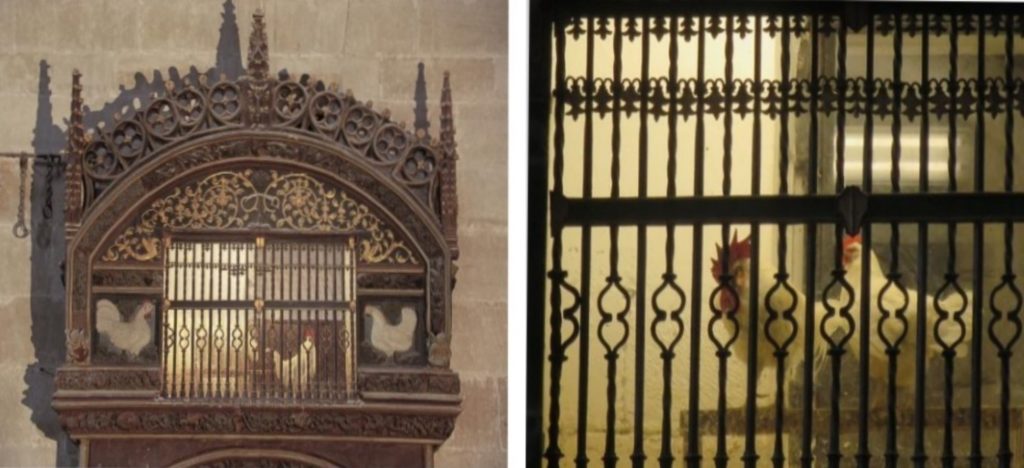
The Virgin and the child who changed position. In the lunette above the entrance door of the Rocamador church at the exit of Estella, you can see a statue of Our Lady the Queen, who, against all tradition, holds the sleeping child on her right arm instead of her left one. Legend has it that a pilgrim was accused of the death of a man during the celebrations for Santiago. Even without any proof, the pilgrim was still sentenced to death, despite proclaiming his innocence. When it came to carrying out the sentence, the pilgrim, from above the gallows where he was, asked to speak and declared as a testimony of his innocence, that at this moment the baby that the virgin de Rocamador was cradling in her arms, would change position. Those present went to check and had to confirm the miracle. The pilgrim was thus freed and was able to continue his journey.
The crucified Christ of the cathedral of Burgos. The crucified Christ of Burgos Cathedral is one of the images that arouses the most devotion on the part of its inhabitants. It is said that a rich merchant friend of the Augustinians (missionary monks) about to leave for a trip to Flanders, begged them to pray for the good progress of his journey, promising that on his return he would give them a gift. During the return voyage made by sea, while he was sorry for not having procured any gift and therefore not having kept his word, he saw floating above the waves, a wooden box. Hoisted her aboard, she found that it contained a life-size crucifix. Immediately he thought here, this will be my gift. When he arrived in Burgos, a strange thing happened because all the bells in the city began to ring in celebration by themselves. Many miracles are attributed to this Christ on the cross; even in the sixteenth century it was written of as many as 18 deaths miraculously returned to life. The crucifix astonished, because it was made of an unknown material. The inhabitants of the place claimed that it was made of buffalo skin treated with vegetable substances that gave the material a unique plasticity that made the limbs and face of Jesus almost real. nails were real. In fact, it is said that Isabella the Catholic, perhaps a little skeptical about what was said about this crucifix, during a visit, pretended to remove one of these nails to verify if it really was a real nail; in fact the nail came off just like a real nail and Christ’s arm fell like that of a real person. The queen was shocked and recognized that what was stated on the crucifix was true and asked forgiveness for her distrust.
Christ with an outstretched hand (a Furelos). This Crucifix, which is not very large (it is approximately 50cm high), is truly unique. In fact, Christ is attached to the cross with only two nails: one that fixes the left hand and the other the feet. His right hand, on the other hand, is free and is stretched out towards you, as if expecting you to take it. She knows that you are tired, she sees so many pilgrims and therefore, she wants to give you a little relief like a mother when she shakes her baby’s hand to help him walk. Then, as you see Him hanging so that His feet are level with your eyes, it almost seems to invite you – and only you – to accept, in the depths of your heart, whether or not to extend your hand to Him. The legend tells: In a church, a faithful used to go to confession regularly to his parish priest. However, his confessions seemed (as indeed all ours) a bit like a broken record: always the same things and always the same grave sin. “Enough! – the parish priest said to him one day in a severe tone – you must no longer make fun of the Lord. This is the last time I give you absolution for these sins”. Remember that well! ” But a few days later, the penitent was again there to confess his usual shortcomings and his usual grave sin. The confessor really lost his patience, was furious and said to him: “I warned you: I will not give you absolution so you will learn …” Deeply disheartened and full of shame, the poor man stood up in silence. He looked at the crucifix that, hung on the wall, towered over the confessional and, right in that instant, he saw it come alive and say to the priest: “I gave my life for this son of mine, so if you don’t absolve him, I will absolve him. I”. Then, with immense amazement, she saw him detach his right arm from the wood of the cross and slowly lift it to trace the sign of absolution in the air saying: “I absolve you of all your sins, in the name of the Father, and of the Son and of the Holy Spirit “. Since then the hand has remained detached from the nail of the cross and hangs downwards.
To deepen the subject, to find out more and if you too have decided to walk the Camino de Santiago or dream of wanting to do it sooner or later, I suggest you buy my book where you will find out why every year, 300,000 people from all over the world, they decide to tackle the most famous Way in the world. If you too, like me, have always dreamed of giving up everything, aware that the life you lead is not the one you dreamed of as a boy, perhaps my experience could give you the courage that I lacked for 36 years …
Reading my experience, you will discover in detail and above all proven in the “field”:
• the history of the journey (historical notes, symbols and legends) and symbolic places;
• suitable clothing and shoes, which backpack to buy and above all what to put inside;
• duration and distance of the journey, how many days it takes to complete it and where to start based on the days available;
• how to train before leaving and the necessary physical preparation;
• how much does it cost to walk the path, where to eat and sleep along the path;
• whether walking the path alone can be dangerous for a woman and whether there is a possibility of getting lost;
• the answer to many questions and concerns (which were also mine) posed by many aspiring pilgrims and the possibility of contacting me to dispel all your doubts / hesitations;
• finally, I will tell you why a journalist and radio host gave up his whole life of comfort and materiality, to travel more than 900 km on foot from the Pyrenees to the Atlantic Ocean, alone and without a telephone, sleeping over that in the various hostels also on the street, in a stable, in a tent, in an abandoned monastery and living two days in a hippie community.
…. ” I gave up everything, I left home, sold my car, motorcycle, clothes, my rolex and most of the material things I owned to follow that almost nagging, suffocating, undeterred feeling that once known does not make you find peace: SANTIAGO, the Camino de Santiago. My life needed answers that only a journey in complete solitude could give me “….
If you want to get to know me better, in the link below you will find an interview where I talk about my experience 👇👇👇
https://www.italianmadhouse.com/libri/i-dropped-everything-to-do-santiagos-way-cesare-desertos-book/



